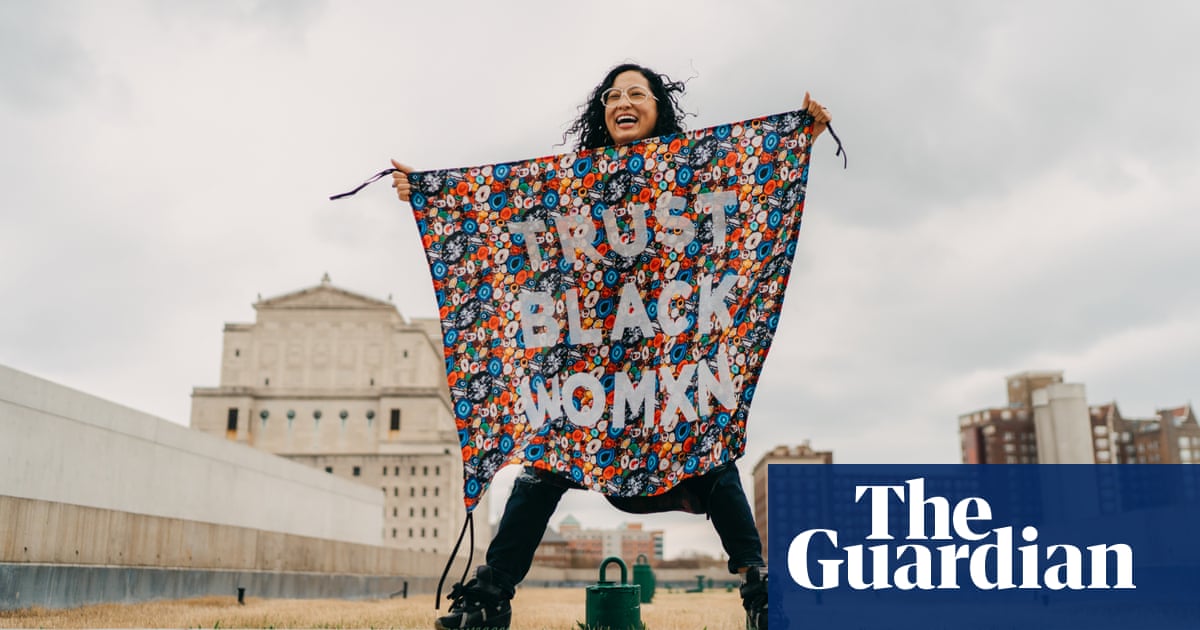Show caption Aram Han Sifuentes’ exhibition in Los Angeles includes protest banners like this one. Photograph: Virginia Harold/Photo by Virginia Harold, courtesy of Pulitzer Arts Foundation. Art The radical power of sewing: the artist turning textiles into activism A Los Angeles exhibit by Aram Han Sifuentes shows the connection between fabric and her passion for political action Eva Recinos in Los Angeles Fri 29 Apr 2022 11.00 BST Share on Facebook
Share on Twitter
Share via Email
Sewing and textiles have always been a part of the artist Aram Han Sifuentes’ life. Her South Korean immigrant parents operated a dry cleaning business, and she mended her own clothing from a young age.
But it wasn’t until she began learning more about immigrant justice and social justice, while making art on the side, that she saw the connection between textiles and her passion for political action. She turned her interests into a career, using textile tools and materials, along with communal workshops, to put that intersection in the spotlight.
The radical power of sewing is the subject of a new exhibition in Los Angeles, on view through 4 September. The show, titled Talking Back to Power: Projects by Aram Han Sifuentes, will include works by the artist such as a sculpture comprised of safety pins; quilts made from clothing scraps that she gathered during interviews with immigrant garment workers; and conversation-sparking protest banners made of fabric.
Aram Han Sifuentes, an immigrant from South Korea, allows her experience to influence her art. Photograph: Tori Soper Photography/Courtesy of Aram Han Sifuentes
The exhibition comes as the fashion world grapples with issues from worker exploitation to environmental harms. Sewing is often dismissed as a feminine and domestic act, but the reality is that garment workers – often immigrant women, people of color or those who are incarcerated – power a billion-dollar global industry. Sifuentes said she sees a clear “absence of an acknowledgment about who’s doing the sewing and the garment work right now in this country”, and hopes her work can shift that.
For example, her US Citizenship Test Sampler Project, a project first established in 2015, turns the classic embroidery sampler, a traditional tool for teaching needlework, into a method of empowerment and critique. Non-citizen participants created samplers during workshops and some of these pieces are in the exhibition, with information on who created them and in what year. The samplers sell for $725, the price of a US citizenship application fee, and the proceeds go to the person who created the piece.
The US Citizenship Test Sampler Project turns classic embroidery into a method of empowerment. Photograph: Jayson Cheung/Courtesy of Aram Han Sifuentes
Samplers are created by non-citizens and sell for $725, the price of a US citizenship application fee. Proceeds go to the person who created the piece. Photograph: Jayson Cheung/Courtesy of Aram Han Sifuentes
Talking Back to Power also includes works that build on Sifuentes’s themes by exploring the historical experiences of immigrant garment workers. In one gallery, Skirball curator Laura Mart said, a 1990s Hamish Amish Immigration Quilt by the Hamish Amish Quilters references “immigration stories of Jewish Americans as made by their descendants”. Many Jewish immigrants who came to the US in the late 19th and early 20th centuries worked in the garment industry, Mart said, and the quilt’s placement across Sifuentes’ work makes a clear connection to her work.
In addition, “Yiddish-speaking Jewish immigrants, and women activists, were really important in advocating for unionized workplaces in the garment industry,” Mart said, referencing the 1911 Triangle Shirtwaist Factory fire and subsequent formation of the International Ladies’ Garment Workers’ Union (ILGWU).
Sifuentes’ work ultimately connects the political with the personal: Safety Pins, a piece that took years to produce, is made up of found items and scraps from her parents’ dry cleaning business, stitched into a mandala (a reference to the artist’s Buddhist culture).
“Of course I’m going to use this medium because at the very core, for me, and my personal lived experience, this is about my identity as an immigrant of color,” she said.
Sifuentes is known for making her political art interactive and the Skirball show includes an ongoing project titled Protest Banner Lending Library, which invites people to come together to design fabric banners adorned with political slogans.
Under Sifuentes’ guidance, participants learn new techniques with tools such as sewing machines and irons on hand. They can keep their banners or donate them to the library for someone else to use. Visitors to the Skirball exhibition can check out a banner, returning it when they’re done using it at a protest or demonstration. Monthly workshops will also take place.
The Protest Banner Lending Library invites people to design their own political banner, which they can then donate for others to check out and use. Photograph: Robert Wedemeyer
During a recent member preview, one museum-goer checked out a banner protesting against the war in Ukraine. He wrapped it around himself, like a cloak, and walked around the space with it for the rest of his visit.
“With Aram’s work, what is so interesting is that the artwork itself is really more than the object,” said Mart. “It’s the experience. It’s the participation aspect of it. It’s the activism aspect of it. And it’s the community aspect of it.”
In past versions of the lending library, Sifuentes said that people exchanged information on future protests and shared what their chosen slogan meant to them. The banners take on a life of their own once they leave the space, encouraging participants to consider marginalised groups and re-imagine the act of sewing as a tool for speaking out.
“We can come together, have our voices heard, and have these banners available for people to check out and sort of be allies or co-conspirators,” said Sifuentes. “[They can] carry the voices of the vulnerable communities and people who don’t necessarily feel safe attending a protest.”
